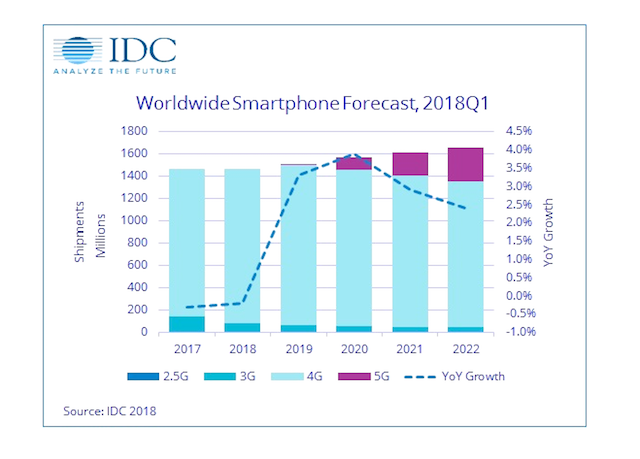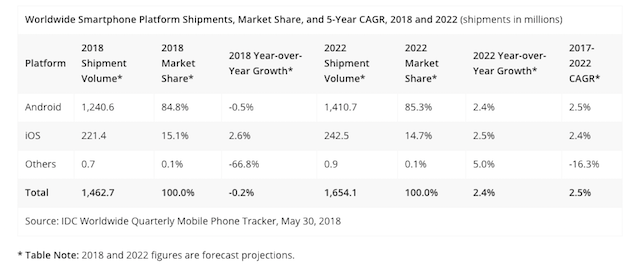Global smartphone sales tipped to decline this year
Global smartphone sales are expected to fall for the second year running this year, before returning to growth next year, according to analysis by the International Data Corporation (IDC).
In the research house’s Worldwide Quarterly Mobile Phone Tracker, smartphone shipments are forecast to drop 0.2 per cent this year to 1.462 billion units, after a 0.3 per cent decline last year.
Looking further out, IDC expects the market is to grow roughly 3 per cent annually from next year onwards, with worldwide shipments reaching 1.654 billion in 2022 and a five-year compound annual growth rate (CAGR) of 2.5 per cent.
The biggest driver of last year’s decline was China, where smartphone sales declined 4.9 per cent year-on-year. And the IDC expects sales in China to decline a further 7.1 per cent this year before flattening out next year.
The biggest growth market in Asia Pacific continues to be India, with volumes expected to grow 14 per cent and 16 per cent this year and next.

“Chinese OEMs will continue their strategy of selling large volumes of low-end devices by shifting their focus from China to India,” says IDC. “So far, most have been able to get around the recently introduced Indian import tariffs by doing final device assembly at local India manufacturing plants. As for components, almost everything is still being sourced from China.”
“With 2017 now behind us a lot of interesting market dynamics are unfolding,” said Ryan Reith, program VP with IDC’s Worldwide Quarterly Mobile Device Trackers.
“Even though it declined 5 per cent last year, China remains the focal point for many given that it consumes roughly 30 per cent of the world’s smartphones.
“But plenty of pockets of growth can be found beyond China. India is now grabbing headlines and the market itself is going through some rapid transformation.
“Local Indian manufacturing continues to ramp up, despite still having a heavy dependence on China for components.
“The boom in India is likely to continue in the years to come, but the move toward building up local production has certainly caught the eye of many in the industry,” he continued.

Outside of Asia Pacific, the biggest regions for growth will be the Middle East, Africa, and Latin America.
All three regions have relatively low penetration rates and plenty of upsides, said IDC.
Economic challenges have been the main inhibitor over the past two years, but IDC expects consumer spending to rise throughout the forecast and smartphones to be a big benefactor.
5G opportunity
The other catalyst to watch will be the introduction of 5G smartphones. IDC predicts the first commercially ready 5G smartphones will appear in the second half of next year with a ramp up across most regions happening in 2020.
IDC projects 5G smartphone volumes to account for roughly 7 per cent of all global smartphone sales in 2020 or 212 million in total. The share of 5G devices should grow to 18 per cent of total volumes by 2022.
“Although overall smartphone shipments will decline slightly this year, the average selling price (ASP) of a smartphone will reach US$345, up 10.3 per cent from the $313 of last year,” said Anthony Scarsella, research manager with IDC’s Worldwide Quarterly Mobile Phone Tracker.
“This year will continue to focus on the ultra-high-end segment of the market as we expect a surge of premium flagship devices to launch in developed markets.
“Devices featuring large Amoled bezel-less displays, advanced camera functions, and an overall increase in speed and performance will be the driving factor in the increase of ASPs. Moving forward, we can expect this trend to continue as the ASP for a smartphone will continue to grow throughout the forecast period.
“In 2022, the final year of our forecast period, the average selling price for a smartphone will be $362, resulting in a five-year CAGR of 2.9 per cent,” he continued.
Android vs Apple
Android’s share is expected to remain relatively stable at 85 per cent of total global smartphone sales. Volumes are expected to grow at a five-year CAGR of 2.5 per cent, with shipments totalling 1.41 billion by 2022.
“There is no question that Android is the OS of choice for the mass market and nothing leads us to believe this will change,” said IDC.
Meanwhile, iPhone volumes are expected to grow 2.6 per cent this year to 221 million.
IDC forecast iPhones to grow at a five-year CAGR of 2.4 per cent, reaching volumes of 242 million by 2022.
With rumours of some upcoming larger screen iOS smartphones, IDC has changed its screen size forecast for Apple by introducing volumes greater than six inches.
Products are likely to begin shipping in the fourth quarter of 2018, with volumes ramping up and accounting for 36 per cent of all iPhones shipped by 2022.
Comment Manually
You must be logged in to post a comment.

No comments